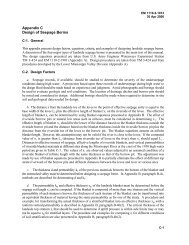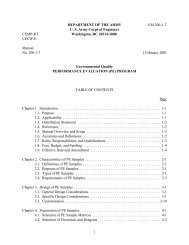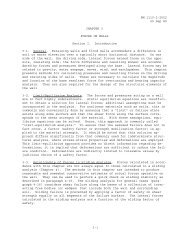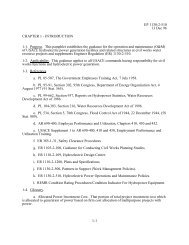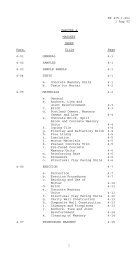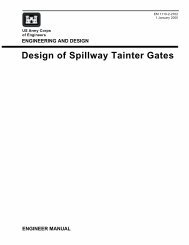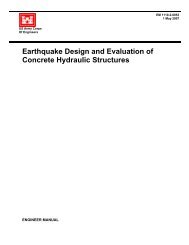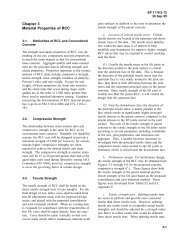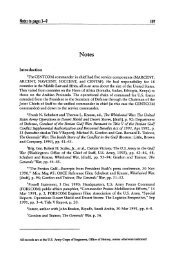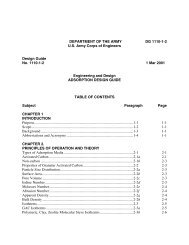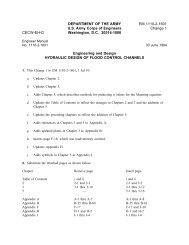Chapter 5 - Publications, US Army Corps of Engineers
Chapter 5 - Publications, US Army Corps of Engineers
Chapter 5 - Publications, US Army Corps of Engineers
Create successful ePaper yourself
Turn your PDF publications into a flip-book with our unique Google optimized e-Paper software.
EM 1110-2-1701<br />
31 Dec 1985<br />
5-7. llow-Duration Metti<br />
(1) The basis <strong>of</strong> this method is a flow-duration curve, usually<br />
constructed from historical records, which describes the percent <strong>of</strong><br />
time different levels <strong>of</strong> streamflow are equaled or exceeded (Figure<br />
5-15). This curve can be readily converted to a power-duration curve<br />
through application <strong>of</strong> the water power equation, and from the latter<br />
curve an estimate can be made <strong>of</strong> the sitets energy potential. The<br />
primary advantages and disadvantages <strong>of</strong> the flow-duration method are<br />
summarized in Section 5-4b, together with a discussion <strong>of</strong> the types <strong>of</strong><br />
studies for which this method is appropriate.<br />
(2) Traditionally, duration-curve energy analyses have been<br />
based on flows for the entire year, and this is <strong>of</strong>ten satisfactory for<br />
preliminary energy potential studies. However, when a project<br />
advances to the point where marketing <strong>of</strong> the Pwer is being studied,<br />
it is usually necessary to prepare duration curves describing the<br />
plantfs energy output by month or by season. The dependable capacity<br />
for most small projects is based on the average capacity available<br />
during the peak demand months (Section 6-7g), and to do this analYsis)<br />
it is necessary to have a power-duration curve based on flows for the<br />
peak demand months.<br />
(3) The following sections describe the basic steps for<br />
computing average annual energy and dependable capacity using the<br />
flow-duration method. The discussion includes a sample calculation<br />
for a typical low-head run-<strong>of</strong>-river project with no wndage.<br />
b. }ata Rea~ements. Table 5-2 provides a summary <strong>of</strong> the basic<br />
assumptions and input data requirements for this method. Further<br />
information on specific items is provided in the corres~nding<br />
paragraphs <strong>of</strong> Section 5-6.<br />
c. Deve~ Curve. The first step is to compile a<br />
flow-duration curve using the available streamflow record, adjusted if<br />
necessary to reflect depletions and current streamflow regulation.<br />
For preliminary studies, flow would be aggregated in classes (flow<br />
ranges) which would produce 20 to 30 well-distributed points on the<br />
duration curve. For more detailed studies, a larger number <strong>of</strong> classes<br />
should be used. The actual compilation <strong>of</strong> the duration curve is<br />
usually done with a computer model. Figure 5-15 illustrates a flowduration<br />
curve for the example project. From the area under the<br />
curve, the average annual flow is computed to be 390 cfs.<br />
d. ~ Flow-Duration wve. If less than thirty years <strong>of</strong><br />
flow data is available, nearby stations with longer periods <strong>of</strong> record<br />
5-42




